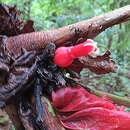en
names in breadcrumbs


Pentagonia is a genus of over 40 species of plants in the Coffee or Gardenia family (Rubiaceae}.[1] Pentagonia species are native to Central America and northern South America, and grow in moist tropical forests below 900m.[2] The genus was first described by George Bentham in 1845.[3] The genus is noteworthy for its opposite pairs of huge leaves in a variety of shapes including entire, shallowly or deeply lobed, and even pinnate. These leaves can, in the case of a recently discovered species (possibly Pentagonia gomez-lauritoi) be up to four feet (1.2 meters) long not including the six inch (15 cm) petiole, and up to 2.5 feet (76 centimeters) in width.[4]
As of April 2021, Plants of the World Online accepted the following species:[1]
{{cite web}}: Missing or empty |title= (help) Pentagonia is a genus of over 40 species of plants in the Coffee or Gardenia family (Rubiaceae}. Pentagonia species are native to Central America and northern South America, and grow in moist tropical forests below 900m. The genus was first described by George Bentham in 1845. The genus is noteworthy for its opposite pairs of huge leaves in a variety of shapes including entire, shallowly or deeply lobed, and even pinnate. These leaves can, in the case of a recently discovered species (possibly Pentagonia gomez-lauritoi) be up to four feet (1.2 meters) long not including the six inch (15 cm) petiole, and up to 2.5 feet (76 centimeters) in width.